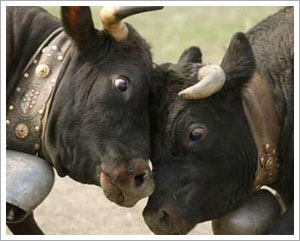But have you heard about cow fighting?
 Saas Fee, Switzerland A loud mooing and then the cow begins to dig its front hoof into the ground, eyeing an opponent across the dirt ring and readying to engage in combat.
Saas Fee, Switzerland A loud mooing and then the cow begins to dig its front hoof into the ground, eyeing an opponent across the dirt ring and readying to engage in combat.
With a few minutes, two female Eringer bovines have locked horns in the fight for hierarchical dominance for which the feisty breed is notorious.
Bullfighting this is certainly not, but in Canton Valais in southern Switzerland, the long-standing tradition of Eringer cow fights is gaining popularity.
Cows from this Alpine breed were inclined to turn viciously on their own kind in the quest for the top spot in the herd and the best pastures. Injuries sometimes occur, but the fight is never to the death.
How this natural phenomenon turned into a spectator sport that culminates in an annual show that drew 90 entrants and thousands of visitors to the town of Saas Fee recently, no one really knows.
Judges preside over bouts that are broken down by weight and age classes, to allow for fair fighting. Only cows already giving milk are allowed to participate.
With up to 10 cows allowed into the ring at a time, several fights can take place at the same time.
For the breeders who treat their cows like pets - hugging and stroking and offering big wet kisses - the fights are about more than just honour and the large and loud Swiss cow bell trophy.
"The cows don't have to fight if they don't want. We can push them a little, try to get them to fight, but if they walk away, we can't force them," said Monica Jurt, a local expert on the Eringer breed, also known as Herens.
"Breeders realized they started fighting each, naturally. And then they started to organize the cow fights," Jurt said. Over the past century, cow fighting has ballooned into a cantonal league event.
Anja Bumann says the performance of her cows gives information on how the mating is fairing. A strong performance means the cows are healthy and improving with each generation. After all, they are ultimately used for milk and meat, particularly the dry beef that the Swiss generally adore.
"We breed our own cows, so as a breeder it is a chance to test out how it is going," Bumann said.
Her cows have won several coveted prizes in recent years, including that of overall title of "queen".
Spectators munch on sausages and traditional raclette - melted cow's milk cheese with potatoes - as they watch the beasts taunt each other and then lock horns, trying to push the other away.
Once a cow has lost a few bouts it is taken out of the ring, until only two remain to duke it out, with some heavy pushing that can take up to 15 minutes.
Saas Fee, situated in a valley in part of towering Alpine mountain range, takes the first part of its name from a slight alteration from the Latin word for "pasture," which some say shows how deeply the pastoral life is rooted in the area.
"For us, the cow fighting is very traditional, and the tradition is very old. But lately it is really starting to become known outside of the Valais," says Saas Fee tourism manager, Simon Bumann.
Traditionally, regional cow fights take place in spring and winter, but with growing interest from tourists, Saas Fee now puts on a special summer show.
This year, Japanese tourists, ultra-Orthodox Jews and German visitors were among the spectators gathered around the ring or climbing up the side of the mountain for a better view.
And while victorious or not, the cow emerges still looking like a cow, joy transforms the face of its owner when the bells reserved for the "queen" of the herd are presented. (dpa)